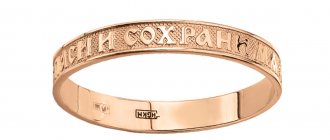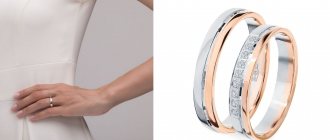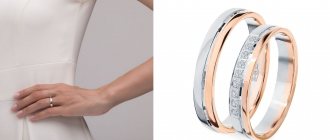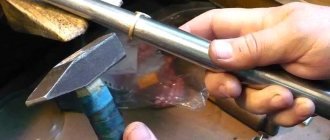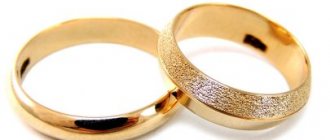There are many ways to save gold jewelry and restore its shine at home. We have already written about various mixtures for removing dirt. They are based on ammonia, water and soap (liquid soap or shampoo). We do not recommend cleaning with washing powders, because they contain a lot of abrasive particles that can damage soft metal.
Today we will figure out how to polish jewelry at home, at the same time removing surface contamination. For these purposes, we will use improvised methods and Goya paste.
How to polish “gold” at home? - the best a:
- Felt can be considered one of the most effective restorers, which can be used to polish a gold ring quite well at home.
- If you use GOI paste, which is used when polishing jewelry in jewelry workshops, the polishing will be much better and more effective.
But if you don’t have felt or GOI paste, then there are a lot of other cleaning methods with which you can easily restore all the scuffs on your jewelry without spending a lot of money.
Gold items with a scattering of stones
You can easily clean them using the same chalk, GOI paste or tooth powder. Run your fingers over the fionits and they will delight you with their shine even faster than gold.
There are products that will be very difficult to clean and polish at home. These are chains with intricate weaving, rings and earrings with technically complex patterns, items with precious stones. You can buy a special gold cleaning liquid for them at home, but it is better to take them to a jewelry workshop.
And some tips on how to handle gold jewelry so you don't have to clean it.
Do you wash the dishes or clean the house? Wear cleaning gloves to protect not only your rings, but also your hands from caustic chemicals. Try not to let your gold ring come into contact with iodine - a chemical reaction may occur that will leave stains on the gold. Remove the ring when performing cosmetic procedures. If you follow these simple rules, you will have to resort to home gold polishing less often.
Cleaning jewelry without inserts
Products that do not have inserts are easy to clean. The most popular representatives of such jewelry are wedding rings.
To restore them use:
- salt;
- soda;
- crushed activated carbon;
- lemon juice or concentrated acid solution;
- medical ammonia in combination with washing powder;
- hydrogen peroxide, liquid soap/shampoo.
To prepare a highly effective product, dilute a few teaspoons of bulk or liquid products in warm water, place the product in the solution overnight, and wipe with a soft cloth in the morning. To enhance the effect, boil the decorations or place them in a container with a solution, at the bottom of which there is a piece of food foil.
Note! It is better not to heat treat items coated with stones or painted with varnish to protect Goya gilding, so as not to damage the top layer.
Polishing and related problems
The biggest problem with polishing is that the process wears out your jewelry. Indeed, during the polishing process, only a small amount of metal is removed from the surface of the product, and one procedure will not greatly harm the product. However, after several treatments, this effect accumulates and the structure of your jewelry becomes weaker.
kaboompics/Pixabay
Pros and cons of professional polishing: jeweler, electrochemical and ultrasonic cleaning
Pros of professional cleaning:
- high efficiency, because special equipment and professional line products are used;
- restoration of various products, including those requiring care: diamonds, pearls, agate, etc.
- the composition of gold is taken into account when working with it, which allows you to preserve the properties of the polished metal and prevent the development of negative processes;
- the ability to restore the product in a short time.
A few nuances worth paying attention to
To keep your favorite jewelry looking new longer and requiring less cleaning, you should follow a few simple rules:
- When washing, cleaning, or hand washing dishes, it is better to remove jewelry. Household chemicals are quite aggressive, so they can damage the coating and cause oxidation and salt deposits.
- When performing cosmetic or medical procedures, you should not wear rings or bracelets, because the substances used can also damage the jewelry.
- It is necessary to remove jewelry made from precious metals at night if you do not want particles of epithelium, secretions of sebaceous and sweat glands to get stuck between the links and clasps of your jewelry.
- It is best to store earrings, rings, bracelets in a place inaccessible to sunlight and humidity, separately from each other, with a cloth.
How to remove scratches from jewelry at home?
Is it probably unpleasant to see scratches on your favorite piece of jewelry? But the situation can always be corrected; the most important thing is to know how to polish a gold ring at home.
Important! Despite the fact that there are a lot of polishing methods, first you must treat the ring with ammonia in order to degrease the surface and clean it of plaque.
Polishing gold from scratches at home:
- The simplest and at the same time quite effective polishing method is using napkins soaked in a special solution. They are mainly sold in jewelry stores.
- Toothpaste can sometimes come in handy in situations where you need to restore the appearance of jewelry. But you can only use those compositions that do not have colored pigments. First, you need to apply a small layer of paste to the surface of the metal, and then polish it using a cotton swab or cotton wool. Successful analogues for polishing a gold ring at home include powder, talc, and tooth powder.
- Using the most ordinary lipstick, you can not only give the desired shade to your lips, but also polish your ring. This is done quite simply. You need to lubricate the metal with lipstick, and then carefully polish the surface using a cotton swab.
We have also prepared a separate article for you, which describes in detail how to clean gold with hydrogen peroxide.
Polishing options: professional or DIY
Before choosing a method for removing scratches, you should consider the available options:
- professional grinding: carried out in the workshop and in departments at jewelry stores; special equipment and products (pastes, solutions) are used to restore products;
- removing scratches yourself: it will not cost much, but it is not always possible to obtain accurate information about the composition of gold, which will certainly affect the result; in addition, there is no guarantee that the surface will be smooth (indentations may form if the product is exposed unevenly).
Features of caring for white gold products
Just like traditional yellow gold, white gold is mined by electrolysis and undergoes a hallmarking procedure. It can be 585, 750 and higher, which indicates the high quality of the metal. In addition, it contains palladium, nickel and silver, which give the jewelry an inimitable white hue. Most often, this alloy is used to make diamond jewelry.
You can clean white gold at home with sugar or a mixture of hydrogen peroxide and ammonia.
Clean with sugar
The recipe is suitable for regular cleaning of minor stains.
For this:
- Dissolve in 1 tbsp. warm water 2 tbsp. l. regular sugar.
- Soak your ring or earrings in sweet water.
- Wipe with a soft cloth soaked in the same liquid.
- Rinse off the sugar with running water and polish the jewelry.
Cleaning white or yellow gold at home is not difficult, but if the antique needs restoration, do not take risks. Also take your earrings, chain or ring to a professional if the methods described are not effective enough. This suggests that the contaminants are deeply absorbed into the relief segments, and only an experienced specialist with expensive means and a clay oven used to absorb lead oxide can remove them without damaging the jewelry.
Gold jewelry, especially rings, fade and deteriorate over time from creams, soaps, cosmetics and natural secretions of the skin. Gold can oxidize, become stained, scratched, and stones set into jewelry can also become unusable.
But if you take timely measures and clean gold at home using one of the methods listed below, you can not only return your jewelry to its original appearance, but also extend its life.
Available means
This category of methods is more suitable for gold, the usual 585 or 750 standard, without stones.
Express methods
To quickly put the appearance of your jewelry in order, you can use the following techniques.
- Dissolve 1 tsp. dishwashing detergent in 200 ml of water. Place a rag in the container and dip the items to be cleaned. Boil for 10 minutes, rinse and dry. You can clearly see the effect of this method in the video.
- This mixture has more ingredients, but it also turns out “more vigorous”. Mix 1 cup warm liquid, 1 tsp. dish soap, 40 g hydrogen peroxide and 1 tsp. ammonia. Immerse the gold in this composition for 20 minutes, after which it must be removed, washed and dried.
- Buy sodium hyposulfite at a pharmacy or photography supply store. It can be used to clean even stubborn stains. 1 tbsp. l. dissolve the chemical in a glass of water and put the jewelry there for 20 minutes. Next you need to rinse and dry the products.
Soak
A long stay in a specially prepared liquid allows you to effectively and effortlessly remove dirt. All you need is to prepare the composition, place the jewelry there, leave for the specified time, and then rinse and wipe dry. Sometimes you may additionally need to clean hard-to-reach areas with a brush or cotton swab.
When implementing such methods, it is worth using ceramic or glass containers.
Let's name the four most famous and effective solutions.
- Ammonia and dishwashing detergent In one glass of boiling water, mix one teaspoon each of dishwashing detergent and ammonia. Place the treasures into the resulting mixture and leave for 1–2 hours.
- Baking soda and foil Place foil on the bottom of the container and place decorations on it. Pour it all over with a soda mixture (1–1.5 tablespoons of soda per 1 glass of water) and leave overnight.
- Salt Regular table salt must be dissolved in liquid (3 tablespoons per 1 glass). It is important to thoroughly stir the salt crystals, otherwise they may damage the surface. Exposure time is at least 8–10 hours.
- Sugar 2 tbsp. l. sugar needs to be diluted in 200 ml of water. Soaking trinkets should be at least 3 hours, and if heavily soiled, you can increase the period to 8.
Polishing
No less effective than soaking, but will take more time and effort.
Powders, soda and any abrasives are not suitable for polishing. They irrevocably scratch the surface, and it becomes impossible to restore its original shine.
You can polish treasures using:
- a piece of flannel, velvet or felt - however, it will take quite a long time to work, and, alas, it will not be possible to clean heavy stains;
- onions - cut the root vegetable in half and wipe the decoration with the cut until clean;
- lipstick - it is advisable to use a colorless lipstick. Apply a small amount of lipstick to the fabric and rub the item;
- eraser - it will be able to remove not only unsuccessful pencil strokes from paper, but also plaque from jewelry accessories. It is enough to wipe dirty places;
- vinegar - soak a napkin in vinegar (5–9%) and treat the product;
- beer and egg white - an unconventional but effective method. Mix 2-3 tbsp. l. beer with 1 egg white and spread with a rag on a bracelet or earrings and polish thoroughly;
- paste - it can be prepared from toothpaste, chalk, grated laundry soap, Vaseline and warm water. All components are mixed in equal parts. Apply the mixture to the surface to be polished and rub gently in one direction. Afterwards, you need to wipe the item with alcohol to wash off the Vaseline.
After any treatment, rinse the jewelry, wipe and dry.
Cleaning items with stones
Values with inserts require special treatment. If the stone is glued, immersion and prolonged contact with liquid may cause the glue to dissolve. Then the pebble simply falls away.
You should also know that stones are different.
- Cubic zirconias, diamonds, topazes, sapphires, peridots, garnets, emeralds, rubies and zircons are hard stones, and they can easily withstand cleaning by almost any means.
- Corals, pearls, malachite, turquoise, opal are soft rocks that require a reverent attitude. It is unacceptable to use brushes, toothpaste and other similar tools and substances. They also do not tolerate moisture well. It is not allowed to rub them with ammonia, as it will make the inserts cloudy. Pearls categorically do not tolerate acid, so you will have to immediately forget about vinegar and lemon.
Now let's talk in more detail about what recipes and methods are allowed.
A universal composition for any type of material is a warm soap solution. In the case of hard stones, you can use a soft brush, and for sensitive rocks, use a cloth.
For caring for hardwood, the following method can be recommended. Shake a teaspoon of ammonia in ⅓ glass of water and immerse the accessories there. After a few minutes, shake the glass to remove dirt in hard-to-reach places. After 10 minutes, the treasures need to be removed and washed. This technique will help get rid of difficult stains.
To remove greasy deposits and stains from diamonds and emeralds, use gasoline. Soak a rag in the fuel and rub the stone. You can do the same with hydrogen peroxide.
Corals, turquoise and hard rocks can be polished with a cotton pad soaked in alcohol.
Removing dirt from white gold jewelry
The addition of silver, nickel or palladium, as well as rhodium plating, takes away the yellow tint from gold. These products require careful handling due to the fact that the rhodium layer is very thin and there is always a risk of damaging the coating. Therefore, it is forbidden to use mechanical cleaning methods and be very zealous when polishing.
You shouldn’t increase the time the jewelry spends in the cleansing mixture.
We can recommend the following options:
- Ammonia and hydrogen peroxide are mixed in a ratio of 1 to 2. Place jewelry in this cleaner and leave for 30 minutes. All that remains is to rinse and wipe.
- A mixture of ammonia and shampoo will be softer. To prepare it, combine ammonia and water in equal quantities, add a little shampoo to them. Exposure time – 30 minutes.
- The recipe we already know with sugar cleans well. Let's remember: 2 tbsp. l. per glass of liquid. Soak for 8–10 hours.
Cleaning Matte Gold
The matte effect is achieved through a special grinding technology. To avoid damaging the surface, carefully choose your treatment methods.
First of all, you should avoid any abrasives and rough brushes, i.e., anything that can scratch the metal.
This mash will help remove dirt: you need to prepare a liquid paste from water and lime (1 coffee spoon). Next, add a small pinch of salt and half a coffee spoon of soda. The finished mixture will have to sit for 3 days.
This is interesting: Partner childbirth: advantages, indications and contraindications
After this time, dip the jewelry into the mixture and wait 4 hours. Then rinse them and blot them with a cloth.
A 25% ammonia solution will also work. You need to place jewelry in it for several hours. Then rinse and dry your treasures.
Attention! This method is prohibited for items with inserts.
Cleaning medical gold
Medical gold is an alloy of brass, silver, copper, titanium and zinc, but there may be no gold in it at all: the alloy already has a noble “golden” luster. Products made from medical gold are durable, not subject to external mechanical influences, and due to the special technology of polishing and sputtering, they practically do not darken, do not lose shine, and do not change color.
- If it is necessary to clean such jewelry from contamination, the following methods are used:
- Rinse in a solution (2 drops of shampoo or liquid soap per 0.5 cup of water) and clean the product with a soft brush.
- To remove dust, wipe the product with a cotton swab soaked in beer; there is no need to rinse with water after this.
- Wipe the decoration with table vinegar, and then be sure to rinse in running water.
Why is polishing white gold bad?
While rhodium plating makes the piece look shiny and white, it is not a great candidate for polishing precisely because of this finish.
Every time you take your jewelry to a professional, your piece is polished using an abrasive material that removes a tiny layer from the surface of the jewelry.
This is usually done using a machine that has a rotating sanding disc. The process of smoothing your ring removes a microscopic layer of metal from the ring until the surface is smoother.
And as you might have guessed, each time your jewelry is polished, the process removes some of the rhodium plating, little by little.
If the top layer of your jewelry has already worn away after long wear, polishing can remove whatever layer of metallization is still there, revealing the yellowish alloy underneath.
Even if the piece is not very worn, it may have deep scratches that require heavier polishing to remove, removing much of the rhodium.
Method two - Goya paste
If you have already tried at least a little to understand the issues of cleaning gold at home, then you have probably come across methods using Goya paste. This means you know that with the help of this abrasive you can clean not only gold items, but also copper coins, silver and much more. But do you know the insidious nuance of this paste?
In order not to spoil the product, it is worth considering that Goya paste has 4 different compositions. Accordingly, there are options on sale that differ in abrasive ability. Remember, gold is a soft metal and the top layer is very easy to remove. Therefore, you should approach the choice of pasta very carefully.
For gold, it is best to use a black paste, which is suitable specifically for polishing and has an abrasiveness of 0.3-0.1 microns. Due to chromium oxide, which makes up approximately 75% of the paste, you will get a pure mirror shine.
How does it work.
Apply the paste to the fabric (for this it is best to take a waffle towel or flannel), rub the ring, earrings or bracelet, polish with clean and dry velvet.
Disadvantages of the method.
If you use green, highly abrasive paste instead of black paste, you risk damaging your gold and reducing its weight. Of course, this will not be noticeable from the outside. But if you want to exchange the product for another one with an additional payment for the work, you will be unpleasantly surprised when weighing it in the store.
Bottom line.
If you want to polish gold using GOI, then choose only black paste.
Reviews
I have a friend who is a jeweler and I constantly ask for advice. From the latter: he told me that soap is not such a safe method, because it leaves an invisible film on the product, it needs to be washed thoroughly. Now I try to use the mildest products (for example, toothpaste, without additives).
Nastya Grineva, Beloretsk
Maria Dubtsova, Krasnodar
Cleaning gold with my lipstick. If on the road I find that the ring has turned pale, I immediately take out a napkin. I apply lipstick and rub the jewelry with this product. I do this regularly, and therefore I don’t have to put in too much effort to restore the attractiveness of the ring.
I didn't like the effect after using salt. The ring seemed to have become cloudy. But I found a mistake - I didn’t leave it in the solution, and apparently scratched it when I rubbed it. I had to take it to the workshop for polishing.
Nastya Rybina, Tula
Why is polishing needed?
Basically, there are several reasons why you need to polish periodically:
- Firstly, this is required by aesthetics, because dregs in the ring or blackening in the earrings, as well as stains that spoil the entire appearance of the chain, do not look aesthetically pleasing.
- Secondly, without polishing, your ring will be a good haven for pathogenic bacteria. In such an environment they can reproduce especially quickly. This results in an acute allergic reaction, and sometimes symptoms associated with intestinal diseases.
Before polishing your jewelry, learn how to clean gold with stones at home.
Why does a gold ring lose its appearance? Why is regular polishing necessary: aesthetics and hygiene
If you constantly polish, this will eventually lead to thinning of the treated area and its deformation (the risk is especially high when polishing yourself). This means that it is important not only to find a suitable method for removing scratches, but also to eliminate the causes of their formation:
- mechanical damage due to impact;
- a natural change in shape at the slightest pressure is a manifestation of the low quality of the ring;
- improper use: jewelry is not removed before taking a bath, playing sports, cooking, etc., and microdamages are intensively formed.
The need for polishing is determined by the following factors:
- aesthetics: a scratched ring looks sloppy and loses its attractiveness;
- hygiene: scratches help create suitable conditions for the proliferation of pathogens - dirt accumulates in such areas.
Golden ring
Tips on how to maintain the shine of a product for a long time
To prevent scratches on a gold ring from appearing again, it is recommended to follow the rules for handling jewelry:
- rings must be removed before washing dishes or doing other housework;
- Before taking a bath and while playing sports, jewelry is removed;
- Do not use cosmetics without removing the ring.
Polished gold ring with diamonds
Polishing gold at home
Check out the ways to restore gold jewelry to its original shine at home. When applied, available materials are used that you will find at home, the cost of home polishing is extremely cheap, the result is pleasing:
- Hot water with shampoo. The soap solution covers rings, earrings, chains so that there are no protruding elements. Leave the products in the water for 7-8 hours. During this time, the fat film will come off. After time has passed, remove the jewelry from the solution and polish with a soft toothbrush.
This method is suitable for both polished and matte gold products.
- Ammonia solution 25%. You can buy it at the pharmacy. Place the Jewelry in a capacious glass or ceramic container and fill it with the solution so that there are no protruding elements on the surface. Leave the jewelry for 10 hours. During this time, the fat will come off.
This method is suitable for both polished and matte gold products.
- Cleaning paste for gold jewelry. You can purchase ready-made pasta or make your own. The composition includes petroleum jelly, powdered white chalk, soap shavings and water. Mix the ingredients to obtain the consistency of liquid cream. The paste is applied with a toothbrush. It is not recommended to press on the brush, as the bristles and paste have abrasive properties, which will lead to scratches on the surface of the product.
- Jewelry stores sell GOI paste intended for polishing gold items. Apply the paste to the felt and rub the product. Make unidirectional movements with minimal pressure on the metal.
- Lipstick. Apply to scuffs and scratches and buff with a cotton swab.
At the end of the procedure for cleaning and polishing gold jewelry, the items should be thoroughly rinsed in running water and laid out to dry.
It is strictly not recommended to use soda or tooth powder for cleaning and polishing gold jewelry, since the coarse structure has abrasive properties, which will lead to the appearance of new scratches.
Category: questions and answers
How to polish grandma's old ring?
Expert opinion
Pribrezhny Gennady Valentinovich
Jeweler 6th category
Antique products are covered with hardened plaque and fatty components, which enhances the antique effect, but they need to be removed. To do this, use the method of soaking in a mild solution. Then carefully remove dirt with a soft toothbrush. If there is a stone on the ring, this method will not work; non-abrasive products are used. Instead of a brush, use a polishing cloth.
After professional polishing, I saw that the white ring had turned yellow in places. From what?
Expert opinion
Grishanov Mikhail Petrovich
Jeweler, director of the Grishanov and Co. workshop
If white jewelry loses color not before, but after polishing, the reason may be the removal of the rhodium layer. This is a common practice: to remove scratches, the protective layer is removed. It can be restored, but most craftsmen charge an additional fee for such work.
How much does polishing cost?
Expert opinion
Pribrezhny Gennady Valentinovich
Jeweler 6th category
The price of the service for restoring the properties of gold varies depending on a number of parameters: the size of the ring, the presence of stones, the method of their attachment, the type of protective coating, the degree of damage to the metal. For this reason, workshops usually provide average prices (200-1000 rubles or more, it also depends on the level of the workshop and region). The exact cost must be clarified on the spot; it will be announced after inspecting the ring.
How to polish a gold ring from scratches at home using improvised means?
Expert opinion
Grishanov Mikhail Petrovich
Jeweler, director of the Grishanov and Co. workshop
They use different methods: powder, talc, tooth powder and paste, as well as special napkins and GOI paste. The choice of option is made taking into account the sample of the metal and the presence of stones. As a rule, fine-grained substances are used to smooth the surface of the gold, and the stones are cleaned with liquid products, woven material and pastes that do not contain abrasives or acids.
Pre-soak in cleaning solution. Popular recipes
As a rule, polishing gold begins with preparing the material. You can make a liquid solution to soak the ring before polishing, or use other ingredients you have at home:
- Soap solution: the detergent is dissolved in water and the ring is left to soak in the container for 2 hours;
- Baking Soda: To further polish your jewelry, let it sit overnight in a container covered with foil and filled with liquid (1 cup warm water, 2 tablespoons baking soda);
- brine: 125 ml water, 3 tablespoons fine salt (sea and coarse salt are highly abrasive); To make the ring shine, leave it in this solution overnight, then rinse and remove moisture
- sugar solution: first leave the scratched rings overnight in a sweetened solution (2 tablespoons sugar, 250 ml water), then rinse under the tap and proceed to the next polishing step
- solution with vinegar or lemon juice: use any acid, but this method can be used at home to clean products without stones, white vinegar (125 ml) will help soften the effect of the product, mix it with baking soda (2 tablespoons), in the working solution soak the ring, but you will need to rinse it after 3 hours
- solution with onion juice: you need to prepare a solution based on the juice of one onion and 2 tablespoons of water and use it to soak jewelry (chains, rings, etc.) for 3 hours;
- “Coca-Cola”: take the drink undiluted, and leave the decorations in the container for 2-3 hours;
- bisulfite solution: this substance will remove dirt in 15 minutes; just mix 1 tablespoon of this product with 250 ml of water
- a mixture of peroxide, ammonia, soda and chalk: take these ingredients in a ratio of 2:2:1:1, the solution is suitable for cleaning a ring without stones, as it acts aggressively; This feature does not allow you to leave the decoration in the solution for a long time - just wait 5 minutes.
Important: cleaning with acid, ammonia and peroxide is not suitable for stones, as they negatively affect the structure of the stone and cause clouding of the gemstone.
Ring or earrings with one large stone
Dirt collects under the stone itself, which is difficult to remove. If you decide to clean and polish such a product at home, we recommend soaking it in a soapy solution for an hour. For these purposes, you can use liquid soap, cream dishwashing gel or shampoo. For shine after cleaning, add ammonia to this mixture and leave the gold in it for at least an hour. The water should be warm, almost hot.
Once you take the product out, you can quickly remove the dirt with a rag. But the residues that have collected on the stone from below can be removed with a toothpick.
Attention!
If you do not want to lose the stone, then you should remove dirt very carefully, without trying to pry off the stone itself.

